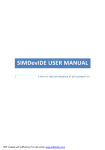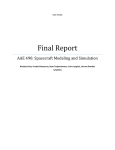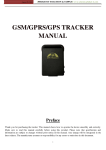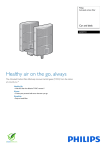Download SIM900R_MPE_Test Report
Transcript
SIMT EMC Lab Report No. 2011J10-30-106093 EN 62311 REPORT Product Name : GSM/ GPRS Module Model No. : SIM900R ACCORDING : EN 62311: 2008 Applicant : Shanghai Simcom Ltd. Address : Build A, No.633 JinZhong Rd., ChangNing District Shanghai, PRC China Issue By : SIMT EMC Lab. Site Address : 716 Yi Shan Road. Shanghai. China TEL : 8621-6470-1390 / FAX : 8621-6451-4252 E-Mail : [email protected] The test results relate only to the samples tested. The test report shall not be reproduced except in full without the written approval of SIMT EMC Lab Page 1 of 5 SIMT EMC Lab Report No. 2011J10-30-106093 Test Report Certification Product Name : GSM/ GPRS Module Applicant : Shanghai Simcom Ltd. Address : Build A, No.633 JinZhong Rd., ChangNing District Shanghai, PRC China Model No. : SIM900R Series No. : 1# Rated Voltage : DC 3.7V Trade Name : SIMCom According : EN 62311:2008 Test Result : Complied Date of Report : 2011.07.15 Documented By : (Zhou Haibei) Tested By : : (Liu Qi) Approved By : (Wang Hui) Page 2 of 5 SIMT EMC Lab 1. Report No. 2011J10-30-106093 RF EXPOSURE MEASUREMENT 1.1 INTRODUCTION This International Standard applies to electronic and electrical equipment for which no dedicated product- or product family standard regarding human exposure to electromagnetic fields applies. This standard is intended to cover both intentional and non-intentional radiators. If the equipment complies with the requirements in another relevant standard, e.g. EN 50371 covering low power equipment, then the requirements of this standard (IEC 62311) are considered to be met and the application of this standard to that equipment is not necessary. The frequency range covered is 0 Hz to 300 GHz. The object of this generic standard is to provide assessment methods and criteria to evaluate such equipment against basic restrictions or reference levels on exposure of the general public related to electric, magnetic and electromagnetic fields and induced and contact current. 1.2 COMPLIANCE CRITERIA The electronic and electrotechnical apparatus shall comply with the basic restriction as specified in Annex II of Council Recommendation 1999/519/EC.The reference levels in the Council Recommendation 1999/519/EC on public exposure to electromagnetic fields are derived from the basic restrictions using worst-case assumptions about exposure. If the reference levels are met, then the basic restrictions will be complied with, but if the reference levels are exceeded, that does not necessarily mean that the basic restrictions will not be met. In some situations, it will be necessary to show compliance with the basic restrictions directly, but it may also be possible to derive compliance criteria that allow a simple measurement or calculation to demonstrate compliance with the basic restriction. Often these compliance criteria can be derived using realistic assumptions about conditions under which exposures from a device may occur, rather than the conservative assumptions that under the reference levels Page 3 of 5 SIMT EMC Lab Report No. 2011J10-30-106093 1.3 ASSESSMENT METHOD The assessments should be made according to an existing basic standard. If the assessment method in the basic standard is not fully applicable then deviations are allowed as long as – a description of the assessment method used is given in the assessment report; – an evaluation of the total uncertainty is given in the assessment report. For transmitters intended for use with external antennas at least one typical combination of transmitter and antenna shall be assessed. The technical specification (under far field conditions) of this antenna shall be documented in detail such that the boundary where the basic restrictions are met can be identified, e.g., by documented radiation patterns. For non-radio transmitting apparatus, the compliance assessment to emissions of E or H field has to be made according to the highest internal frequency used within the apparatus under analysis or at which the apparatus operates with the following criteria: – if the highest internal frequency of the apparatus is less than 100 MHz, the assessments shall only be made up to 1 GHz; – if the highest internal frequency of the apparatus is between 100 MHz and 400 MHz, the assessment shall only be made up to 2 GHz; – if the highest internal frequency of the apparatus is between 400 MHz and Page 4 of 5 SIMT EMC Lab Report No. 2011J10-30-106093 1 GHz, the assessment shall only be made up to 5 GHz. If the highest internal frequency of the apparatus is above 1 GHz, the measurement shall be made up to 5 times the highest frequency. 1.4 EUT OPERATING CONDITION The software provided by Manufacturer enabled the EUT to transmit and receive data at lowest, middle and highest channel individually. 1.5 TEST RESULTS The antenna of the product, under normal use condition is at least 20 cm away from the body of the user. Warning statement to the user for keeping at least 22cm separation distance and the prohibition of operating to a person has been printed on the user’s manual. So, this product under normal use is located on electromagnetic far field between the human body. The field calculation does not take into account the antenna size, which is assumed to be a point source. Far Field Calculation Formula Since the maximum eirp power is used as the output power to antenna, According the Antenna Specification the Antenna Gain as Below: GPRS 900 class 10, 2 up, 3 down: Output Average Frequency Power output Power (MHz) to Antenna to Antenna (dBm) (mW) 897.0 32.10 1621.81 GPRS 1800 class 10, 2 up, 3 down: Output Average Frequency Power output Power (MHz) to Antenna to Antenna (dBm) (mW) 1710.2 29.10 812.83 Antenna Gain (dBi) E-Field Strength (V/m) E-Field Limit (V/m) Pass / Fail 1 39.13 41.19 Pass Antenna Gain (dBi) E-Field Strength (V/m) E-Field Limit (V/m) Pass / Fail 1 27.70 56.86 Pass Page 5 of 5













